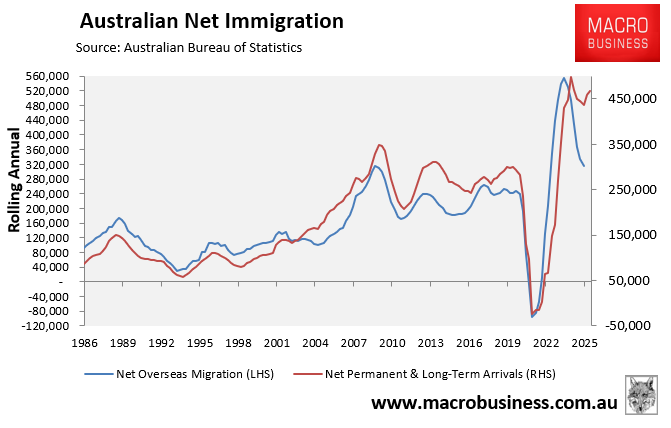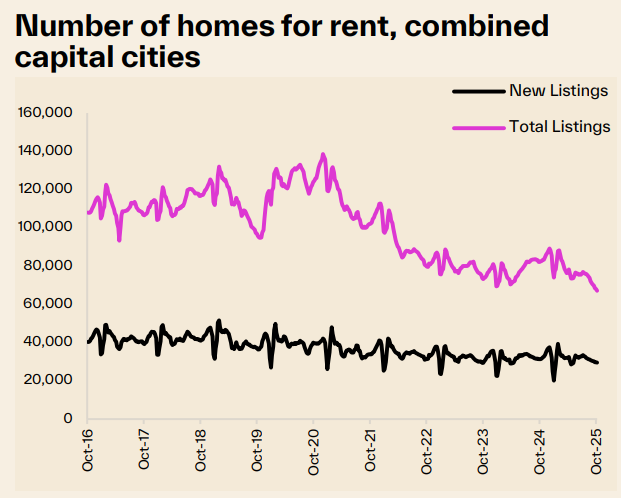The Albanese government’s Housing Accord, signed with the states at National Cabinet in 2023, set a target to build 1.2 million homes over the five years from FY2025 to FY2029. This target requires 240,000 homes to be built annually.
The Australian Bureau of Statistics (ABS) last week released dwelling construction data for the June quarter of 2025, which reported a decline in housing construction.
The number of dwellings that commenced construction in the June quarter declined by 4.4% to 45,156, whereas the number of homes that completed construction plummeted by 6.5% over the quarter to just 40,524.
It was the weakest quarter of dwelling completions for 11 years (i.e., since the March quarter of 2014).
Over FY 2025, total dwelling completions fell by 2% to 174,030, from 177,600 the previous financial earlier.

This meant that during the first year of the Housing Accord, which began on 1 July 2024, only 174,030 dwellings were completed, falling short by 65,970 (27%) of the annual target of 240,000.

It also means that Australia will have to build around 256,000 homes annually over the next four years to meet Labor’s 1.2 million target.
There are multiple reasons why dwelling construction has stalled, including:
- Interest rates are structurally higher.
- Construction costs have risen by more than 40% since the pandemic.
- Residential lot values have risen by around 33% since the pandemic.
- Labour shortages due to government infrastructure projects and high rates of bankruptcy.
The AFR reported on Friday that an executive at property developer Mirvac warned of a potential downturn in the Australian construction sector next year.
“The one thing that I’d call out, which is evident in Victoria at the moment, is that the major subcontractors that engage with us as builders are flagging a significant drop-off in workbook next year—a lot of government projects are completing and not a lot of new large-scale apartment projects coming out of the ground – [which] is a concern”, said Mirvac chief executive of development Stuart Penklis at Citi’s annual investment conference last week.
Penklis noted that crews are now laying off staff.
The AFR also reported last week that Australia is facing a growing shortage of apprentices, which is hindering housing supply.
Just 10,165 people completed an apprenticeship in the first quarter of 2025, the lowest figure in a decade—except for during the pandemic. The construction trades suffered the biggest decline.
Meanwhile, demand via immigration seems to be increasing:
At the same time as dwelling construction has stalled, the latest data on net permanent and long-term (NPLT) arrivals from the ABS hit a record high over the first eight months of 2025, suggesting that net overseas migration has reaccelerated from already historically high levels.
In the year to August 2025, a record 379,870 NPLT arrivals landed in Australia, up 22,930 (6.4%) from the 356,940 net arrivals that landed last year and 138,460 (57.4%) higher than the same period in 2019, before the pandemic.

Historically, the monthly NPLT arrivals series has closely tracked the official quarterly net overseas migration (NOM) series, which runs on a six-to-nine-month delay.

Therefore, the data suggests that NOM is rising again.
The Albanese government recently announced that it has raised the planning level for international students by 25,000 to 295,000 for 2026, which will keep immigration elevated next year.
This apparent resurgence in immigration is likely behind the retightening of the nation’s rental market.
The number of homes listed for rent nationally, alongside the vacancy rate, has collapsed to a record low.

Source: Cotality
As a result, Cotality reports that capital city rental growth has accelerated, which follows a 43.8% ($10,500) increase over the previous five years.

It is difficult to see how the rental situation will improve given that dwelling construction has fallen at the same time as net overseas migration appears to have reaccelerated.

